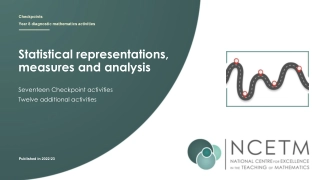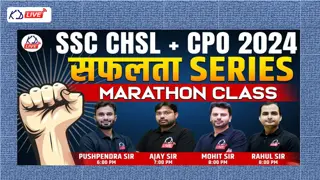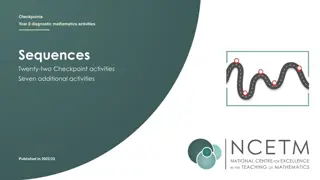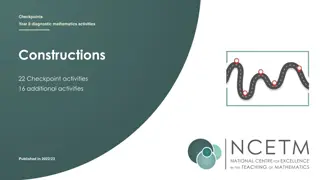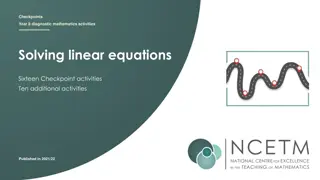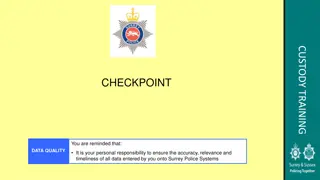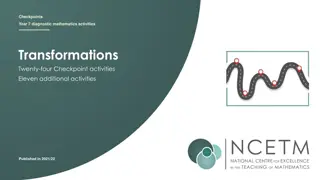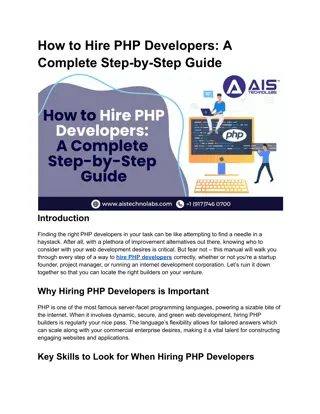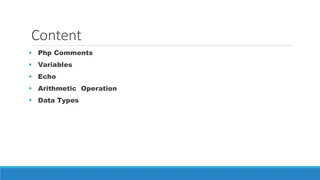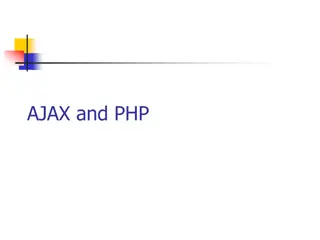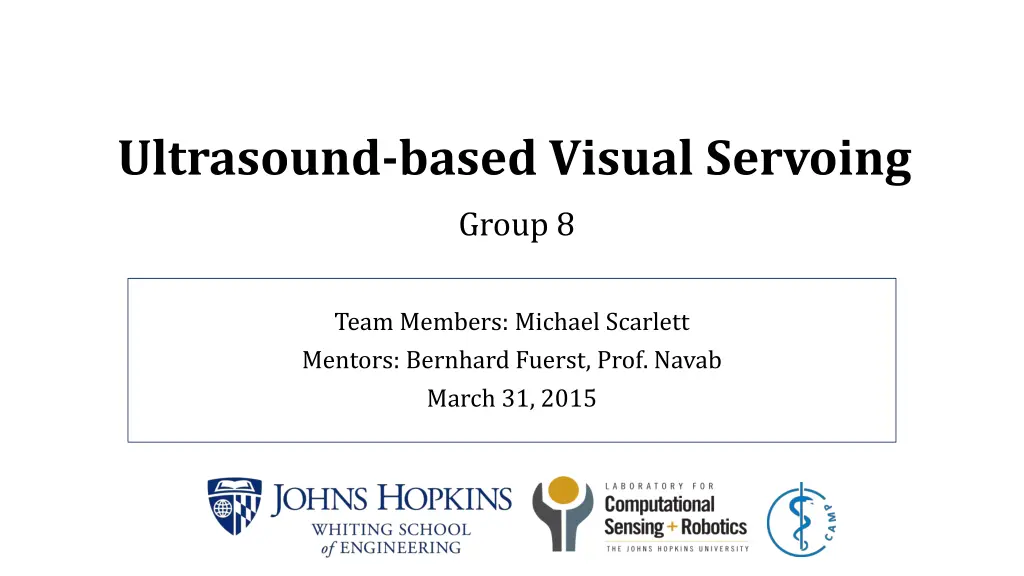
Ultrasound-based Visual Servoing for Robotic Control
Explore how ultrasound-based visual servoing enhances robot control for precise movements in medical procedures. Using advanced technology, this project aims to automate ultrasound probe positioning based on real-time images, offering superior dexterity and accuracy compared to manual methods.
Download Presentation

Please find below an Image/Link to download the presentation.
The content on the website is provided AS IS for your information and personal use only. It may not be sold, licensed, or shared on other websites without obtaining consent from the author. If you encounter any issues during the download, it is possible that the publisher has removed the file from their server.
You are allowed to download the files provided on this website for personal or commercial use, subject to the condition that they are used lawfully. All files are the property of their respective owners.
The content on the website is provided AS IS for your information and personal use only. It may not be sold, licensed, or shared on other websites without obtaining consent from the author.
E N D
Presentation Transcript
Ultrasound-based Visual Servoing Group 8 Team Members: Michael Scarlett Mentors: Bernhard Fuerst, Prof. Navab March 31, 2015
Topic Ultrasound Visual Servoing Automatic feedback control of robot as a function of input image and reference image Use current ultrasound volume to automatically move robotic ultrasound probe to volume of interest Current ultrasound volume Move Volume of interest Final position Current position
Topic Ultrasound Visual Servoing 1. Doctor chooses volume of interest within reference image 2. Use current ultrasound volume to find transformation to volume of interest 3. Move ultrasound probe 4. Repeat 2-3 until error is small Ultrasound probe Volume of interest R, t Ultrasound volume Reference image
Motivation During procedure, reference image differs from current anatomy due to deformations and organ movement Robotic ultrasound provides superior dexterity relative to hand-held ultrasound and allows 3D reconstruction
Project Goal ImFusion plugin that uses visual servo control of KUKA robot to move ultrasound probe to volume of interest
System Setup Select volume of interest User interface Workstation Visual servo control of robot KUKA robot Movement of ultrasound probe and current position Ultrasound probe Acquire ultrasound image Ultrasound phantom Experimental testing and validation
Image Analysis (ImFusion) A A T(B) Volume of interest Similarity measure Optimizer Bi ? =? ? 1 B T(B) 0 3D ultrasound image compounding Tracked ultrasound slices Interpolator Transform Robot communication (ROS and KUKA Sunrise) no ImFusion ROS node Is |T| small? ROS core Ultrasound probe Move KUKA yes Sunrise.Connectivity ROS node END Sunrise.Connectivity KUKA Robot
Current progress ROS ROS acts as middleware that decouples software components and enables message passing between processes ROS consists of master coordination node and publisher/subscriber nodes that post and receive messages ROS core Subscriber: I heard Hello World Publisher: Hello World
Current progress ROS Need ROS to be compatible with ImFusion SDK, but Windows support for ROS is currently experimental Compile ROS and its dependencies from source using WinRos
Current progress ROS A standard way is needed of communicating transformations Use Pose message which consists of a 3D point and a quaternion
Current progress ROS 3D rotation matrix can be represented as a unit quaternion ? = ???????? ?????? ? ???? ? = ???????? ?????? ? ???? ? = ???????? ?????? ? ????
Current progress ROS Currently working on ROS plugin for ImFusion Collaborate with other students who are creating a ROS node for KUKA Sunrise which will accept a Pose message ROS core KUKA Sunrise ImFusion ROS node
Deliverables Minimum ImFusion plugin for communication between ImFusion and KUKA robot ImFusion plugin for automated registration of ultrasound volume with volume of interest to obtain transformation Ultrasound probe ImFusion ROS node KUKA Sunrise KUKA robot Transformation ROS core Volume of interest
Deliverables Expected Given an initial location adjacent to phantom and volume of interest, move robotic ultrasound probe to location of volume of interest Perform validation of path planning on different ultrasound phantoms Evaluate performance of different registration techniques Provide documentation of completed portions Ultrasound probe Motion planning ImFusion ROS node KUKA Sunrise KUKA robot Transformation ROS core Volume of interest
Deliverables Maximum Integrate Kinect sensor with visual servoing system Given the volume of interest and initial location away from phantom, move robotic ultrasound probe to location of volume of interest Kinect sensor Ultrasound probe Motion planning ImFusion ROS node KUKA Sunrise KUKA robot Transformation ROS core Volume of interest
Original timeline Notes Feb 13 Feb 20 Feb 27 Mar 6 Mar 13 Mar 20 Mar 27 Apr 3 Apr 10 Apr 17 Apr 24 May 1 May 8 Learn ROS Make first ROS node Set up ImFusion Perform literature review First control of robot from ImFusion ImFusion plugin for robot control First image transformation ImFusion plugin for image transformation First ultrasound image acquisition System-level integration of modules Obtain correct ultrasound volume given volume of interest and location adjacent to ultrasound phantom System testing and validation Integrate existing modules with Kinect sensor plugin Obtain correct ultrasound volume given only volume of interest
Revised timeline Notes Feb 13 Feb 20 Feb 27 Mar 6 Mar 13 Mar 20 Mar 27 Apr 3 Apr 10 Apr 17 Apr 24 May 1 May 8 Learn ROS Make first ROS node Set up ImFusion Perform literature review First control of robot from ImFusion ImFusion plugin for basic robot control First image transformation ImFusion plugin for image transformation First ultrasound probe acquisition System-level integration of modules Obtain correct ultrasound volume given volume of interest and location adjacent to ultrasound phantom System testing and validation Integrate existing modules with Kinect sensor plugin Obtain correct ultrasound volume given only volume of interest
Dependencies Resolved Ability to meet mentors Workstation with ImFusion and KUKA robot Ultrasound probe and phantoms Kinect sensor Additional Collaborate with other students to create ROS node for KUKA Sunrise
Reading list Abolmaesumi P, Salcudean SE, Zhu WH. Visual servoing for robot-assisted diagnostic ultrasound. Proc 22nd Annu Int Conf IEEE Eng Med Biol Soc (Cat No00CH37143). 2000;4:2532-2535. doi:10.1109/IEMBS.2000.901348. Abolmaesumi P, Salcudean S, Sirouspour MR, DiMaio SP. Image-guided control of a robot for medical ultrasound. IEEE Trans Robot Autom. 2002;18(1):11-23. doi:10.1109/70.988970. Bischoff R, Kurth J, Schreiber G, et al. The KUKA-DLR Lightweight Robot arm a new reference platform for robotics research and manufacturing. In: Joint 41th Internatiional Symposium on Robotics and 6th German Conference on Robotics.; 2010:741-748. Chaumette F, Hutchinson S. Visual Servo Control. IEEE Robot Autom Mag. 2007;1(March):109-118. Chatelain P, Krupa A, Navab N. Optimization of ultrasound image quality via visual servoing. 2015. Choset H. Principles of Robot Motion: Theory, Algorithms, and Implementation. (Choset HM, ed.). MIT Press; 2005:603. Available at: http://books.google.com/books?id=S3biKR21i-QC&pgis=1. Accessed October 27, 2014.
Reading list Conti F, Park J, Khatib O. Interface Design and Control Strategies for a Robot Assisted Ultrasonic Examination System. Khatib O, Kumar V, Sukhatme G, eds. Exp Robot. 2014;79:97-113. doi:10.1007/978-3-642-28572-1. Fuerst B, Hennersperger C, Navab N. DRAFT : Towards MRI-Based Autonomous Robotic US Acquisition : A First Feasibility Study. Gardiazabal J, Esposito M, Matthies P, et al. Towards Personalized Interventional SPECT-CT Imaging. In: Golland P, Hata N, Barillot C, Hornegger J, Howe R, eds. Medical Image Computing and Computer-Assisted Intervention MICCAI 2014.Vol 8673. Lecture Notes in Computer Science. Cham: Springer International Publishing; 2014:504-511. doi:10.1007/978-3-319-10404-1. Janvier M-A, Durand L-G, Cardinal M-HR, et al. Performance evaluation of a medical robotic 3D- ultrasound imaging system. Med Image Anal. 2008;12(3):275-90. doi:10.1016/j.media.2007.10.006. Krupa A. Automatic calibration of a robotized 3D ultrasound imaging system by visual servoing. In: IEEE International Conference on Robotics and Automation, 2006.Vol 2006.; 2006:4136-4141. doi:10.1109/ROBOT.2006.1642338.
Reading list Nakadate R, Matsunaga Y, Solis J. Development of a robot assisted carotid blood flow measurement system. Mech Mach Theory. 2011;46(8):1066-1083. Available at: http://www.sciencedirect.com/science/article/pii/S0094114X11000607. Accessed August 25, 2014. Schreiber G, Stemmer A, Bischoff R. The Fast Research Interface for the KUKA Lightweight Robot. In: IEEE Workshop on Innovative Robot Control Architectures for Demanding. ICRA; 2010:15-21. Shepherd S, Buchstab A. KUKA Robots On-Site. McGee W, Ponce de Leon M, eds. Robot Fabr Archit Art Des 2014. 2014:373-380. doi:10.1007/978-3-319-04663-1. Tauscher S, Tokuda J, Schreiber G, Neff T, Hata N, Ortmaier T. OpenIGTLink interface for state control and visualisation of a robot for image-guided therapy systems. Int J Comput Assist Radiol Surg. 2014. doi:10.1007/s11548-014-1081-1.

